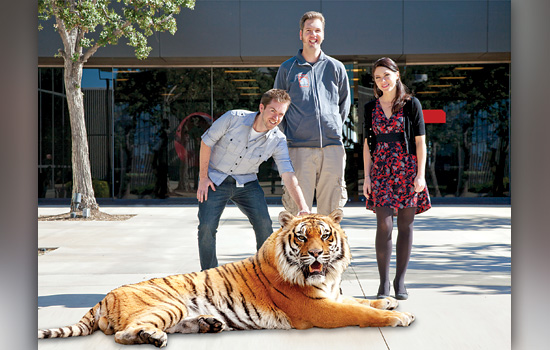Tigers make a tiger
Photo by Rhythm & Hues
Scott Vosbury ’04, Rich Enders ’02 and Jen Stratton ’05 helped create the digital tiger in Life of Pi.
Three graduates from the School of Film and Animation helped create the digital Bengal tiger in Life of Pi, which won an Academy Award for Best Visual Effects in February.
Scott Vosbury ’04 (film and animation), Rich Enders ’02 (computer graphic animation) and Jen Stratton ’05 (film and animation) work for Rhythm & Hues, a character animation and visual effects studio in Los Angeles.
Vosbury worked as a lead digital compositor for the film with a team responsible for scenes involving Pi being stranded at sea, animal attacks and flying fish.
“It’s my job to take all the elements and assets from every other department and seamlessly integrate them on screen. It’s my job to make you believe the unbelievable.”
Enders was a tracking supervisor for the film, one of about 40 artists who made sure the characters’ positions were in sync with the movement of other objects, such as waves and the boat.
And Stratton was responsible for delegating tasks and managing the texture team, ensuring image surfaces looked the way they were supposed to look. “I helped make sure we maintained a high degree of quality and would assist my team in growing each individual’s skill set,” she says.
An actual tiger was used in 24 of the 170 shots in the movie, but the animation is so lifelike, it isn’t obvious which tiger image is real.
Vosbury says about 600 people from Rhythm & Hues worked on the film. But only four names could be listed on the Oscar nomination ballot; two are from the studio. Rhythm & Hues artists won Visual Effects Oscars for The Golden Compass in 2007 and Babe in 1996.
“More than any other project we have worked on so far, I was astounded by the quality of work we had produced,” Stratton says. “I am proud to tell others I was a part of the process.”
Being a devoted RIT alumnus, Vosbury said the thought did occur to him to call the digital tiger “Ritchie” after the RIT mascot.
“Apparently the author, Yann Martel, sold a couple million copies of the novel with the tiger named ‘Richard Parker,’ and I don’t think the fans of the book would have been too pleased with the change.”















